Moldovan cooking developed over centuries in the fertile lands between the Prut and Dniester rivers, where a temperate climate, rich soils, and rolling farmland supported abundant agriculture. Early inhabitants, including Thracians and Dacians, cultivated wheat, barley, and grapes, while herding sheep and cattle for dairy and meat. Roman rule expanded viticulture, but bread, dairy, and seasonal produce remained staples, with meat reserved for special occasions.
Long, warm summers and mild autumns encourage the cultivation of corn, sunflowers, vegetables, and fruits, shaping a cuisine centered on mămăligă, fresh and preserved produce, and orchard harvests.
From the 13th century until 1812, the Principality of Moldova was a vassal state of the Ottoman Empire, which brought influences from Turkic, Greek, Arab, and Armenian cooking. Dishes like sarmale, tocăniță, and ghiveci, became common, along with sweetcorn, now central to Moldovan cooking.

In 1812, the Russian Empire annexed eastern Moldova, introduced borsch, pelmeni, colțunași (vareniki), sour cream, fermented cabbage, potatoes, and greater use of pork eventually spread. Slavic traditions of pickling were enthusiastically adopted, with Moldovans preserving everything from tomatoes and cucumbers to melons and cauliflower.
Despite Moldova’s modest geographical size, the culinary traditions vary by region: the north favors pork and dairy, the center leans toward vegetable-based dishes, and the south features more fish, mutton, and fruit, alongside traditions from the Gagauz – a Turkic ethnic group who live in the south of Moldova.
As a whole, there are many dishes that Moldovans simply could not live without: sarmale, mămăligă, plăcinte, zeamă, and many of the various traditional meat dishes. Seasonings also make Moldovan food Moldovan, with garlic, dill, parsley, lovage, paprika, and bay leaf very common. Wine is a national pride.
Moldova remains highly agricultural, with many households growing their own produce or sourcing it from local markets. The cuisine is heavy on soups, stews, breads, and stuffed pastries that are hearty, seasonal, and deeply rooted in both the land and the cultural crossroads where Moldova sits.
Adjică: (Sauce) Made from blended hot peppers, carrots, garlic, herbs and sometimes tomatoes, this is a spicy sauce from Georgia, where it is known as Adjika. It is served with grilled meat, fish, vegetables, mushrooms, and especially potatoes. Moldovans also love to eat it as a spread on bread, alongside some slănină (salo).
Alivancă: (Dessert) Famous in the north of Moldova, alivanca is a soft, rustic dessert with a texture somewhere between cornbread and a soft pie. It is traditionally made from cornmeal, milk, cottage cheese, eggs, and sugar. The recipe varies from home to home: some people add raisins and serve it with sour cream, others prefer to top it with homemade jam. When made without sugar, alivanca can also be served as a savory dish, usually with sour cream.
Babă albă: (Dessert) A childhood favorite for many, this sweet noodle pudding originated in northern Moldova and quickly followed the popularity of its richer predecessor, baba neagră. Cooked pasta is combined with eggs, butter, sugar, vanilla, lemon zest, a pinch of salt, and raisins. The whole thing is then baked until golden brown and typically served cold, accompanied by a warm cup of tea and sometimes a drizzle of honey. The name literally means “white hag.”
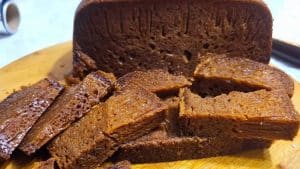
Babă neagră: (Dessert) The “black hag” is also often called the queen of Moldovan desserts. This dense, dark cake from northern Moldova is enjoyed nationwide. Its caramelized color and almost smoky flavor result not from cocoa but from a natural reaction between baking soda and acidic dairy like kefir during a slow, four-hour bake. Vodka or another neutral spirit is sometimes added to help the batter rise, a process that creates the cake’s signature small air pockets. This cake takes skill and time and is traditionally made for weddings and family gatherings. Babă neagră has a sweet, caramel-pudding-like taste, but with a firmer texture. It’s typically served cold, sliced to reveal its airy interior, and paired with tea or vanilla ice cream.
Borș acru: (Ingredient) A traditional fermented liquid used to add flavor and sourness to soups like zeamă. It’s made by fermenting wheat or barley bran in water, often with added bread, sugar beet, or cornmeal to aid fermentation. After several days, the mixture is strained, yielding a pale yellow, cloudy liquid rich in vitamins and probiotics.
Borș: (Soup) Popular across Eastern Europe, borș (or borscht) is a sour vegetable-based soup that may include meat. In Moldovan cuisine, the recipe closely resembles the Ukrainian version, typically featuring beets, cabbage, carrots, potatoes, and onions, with optional additions like pork, beef, duck, or chicken. It’s usually soured with borș acru or lemon juice, then finished with fresh dill, parsley, or lovage. Served hot with sour cream, homemade bread, and optionally a fresh or pickled chili.
Brânză: (Dairy) An umbrella term for dairy products made by coagulation of milk (cheese). It is typically made from cow’s milk, sheep’s milk or goat’s milk. Cow’s milk cheese (brânză de vaci) is the most widely used variety in traditional dishes, such as plăcinte cu brânză, mule, brânzoiace and others. The salty types of cheese (made out of goat or sheep’s milk) can also be used in pies (plăcinte), but they are more commonly served fresh, with tomatoes and bread, or added in salads.
Brânzoaice: (Breakfast) Fresh cottage cheese is mixed with eggs, flour, a bit of sugar and a pinch of salt, then shaped into small, thick patties and fried until golden brown on both sides. Best served warm, topped with sour cream, honey, jam (preferably blackcurrant or raspberry), or fresh fruits and berries, particularly in summer. These are essentially identical to the Slavic dish known as syrniki.
Chișleag: (Dairy) A fermented dairy drink, similar in texture and flavor to buttermilk or kefir. The acidification leads the milk to coagulate and thicken, creating a mixture of liquid and curds. It is typically enjoyed cold, especially on a warm summer day, alongside fresh bread.
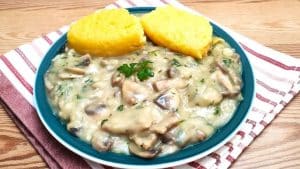
Ciulama: (Main Dish) Tender pieces of chicken and/or mushrooms are simmered in a white sauce made from milk or sour cream thickened with flour. Traditionally, ciulama is served with mămăligă or mashed potatoes, topped with fresh dill or parsley, and often accompanied by pickles to balance the richness of the sauce. Often prepared with just mushrooms for a vegetarian version during lent.
Cighiri: (Main Dish) A traditional meat dish, similar to meatballs. Cighiri are made from a mixture of pork offal (such as liver or heart), minced meat, rice, onion and herbs like bay leaves and thyme. The mixture is wrapped in caul fat (a thin lacy membrane from the pig’s stomach) and then fried or baked. It has a distinctive flavor – not for everyone – but definitely worth a try.
Clătită: (Dessert) A simple batter of flour, milk, eggs, and a pinch of salt, it spread thin on a hot, lightly oiled pan and fried until golden on both sides. Clătite are typically filled with jam, chocolate, sweet cheese, or fresh fruit and then rolled or folded before serving. Savory versions may include cheese, mushrooms, or minced meat.
Colțunași: (Main Dish) The equivalent of Polish pierogi and Ukrainian vareniki, colțunași are filled dumplings shaped like half-moons of unleavened dough stuffed with fillings like potatoes, cottage cheese (either savory or sweet), or sour cherries. Both sweet and savory versions are typically served with sour cream, while savory ones are often topped with fried onions or mushrooms.
Compot: (Drink) Fruits such as strawberries, apricots, peaches, apples, raspberries, grapes, sour cherries, and/or quinces, are boiled in sugar water. The fruit and liquid are then stored in carefully sealed jars in a cool place. A way of preserving fruit for winter, fresh compot is also popular in summer.
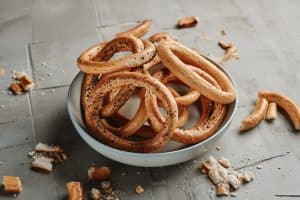
Covrigi: (Breads) Covrigi come in two forms: a larger, soft pretzel or small, hard, crunchy circle. The pretzel type can be sprinkled with coarse salt, poppy seeds, or sesame seeds or filled with chocolate, ham and cheese, or other fillings. In contrast, the circles come in flavors, such as rye, vanilla, poppy seed, salted, or sugar-coated. Saltier versions are often paired with beer.
Cozonac: (Breads) This rich, sweet Easter bread is made from flour, eggs, milk, butter, sugar, lemon zest, and vanilla. Its filling varies, but often includes walnuts, cocoa, and sugar, sometimes with raisins or Turkish delight (rahat). It might also be flavored with poppy seeds, sweet cheese, rum, or orange zest.
Cușma lui Guguță: (Dessert) Literally translated as “Guguță’s Hat,” this beloved Moldovan dessert is named for a young shepherd from lore who dreams of keeping his village warm within his large hat. To make the hat, thin crepes are rolled around sour cherries, stacked in a pyramid shape, held together with generous amounts of sweetened sour cream, and topped with cocoa or grated chocolate.
Cvas: (Drink) A fermented, low-alcoholic beverage with a sweet and sour taste. Black or rye bread is left to ferment in water with yeast and sugar, resulting in a dark-coloured, bubbly drink. It is a quintessential summer drink in much of this part of the world, also known as kvass.
Divin: (Spirit) A moldovan brandy made by distilling local white wine and aging it in oak barrels. It follows a French cognac-making tradition.
Dulceață: (Sauce) A fruit preserve for wintertime, known for its syrupy texture and whole or large fruit pieces. It is made by simmering fruits, such as sour cherries, strawberries, plums, apricots, quinces, green walnuts or even rose petals, with sugar and lemon juice to maintain their color and flavor. It is served with bread and butter or as a topping for pancakes, waffles, cheese, ice cream or brânzoaice.
Fasoliță: (Sauce) Made from boiled white beans blended with sunflower oil and topped with caramelized onions, fasolița is a traditional bean spread or dip, also known as fasole făcăluită, bătută or frecată.
Friptură: (Main dish) Grilled meat, commonly pork, beef, chicken or lamb. The meat is seasoned simply with salt, pepper, garlic and herbs. In many cases, especially with pork and lamb, the meat is marinated beforehand, often with ingredients like garlic, wine, mustard, bay leaves, rosemary and others. Some versions may also include a light sauce made with onions, carrots, and flour for a thicker consistency. Friptura is usually served with potatoes, mămăligă, and pickles.
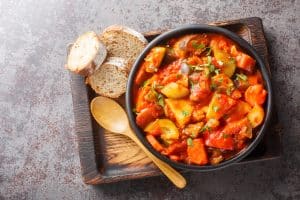
Ghiveci: (Main dish; side dish) A stew, typically made from a variety of seasonal vegetables such as tomatoes, eggplants, zucchini, bell peppers, carrots, and onions, all simmered in oil or tomato sauce. Eaten fresh during summer or jarred for winter. Best served with mămăligă and goat cheese.
Hrișca: (Ingredient) Buckwheat is a staple grain in Moldova, being used in both savory and sweet dishes. For breakfast, it’s often cooked with milk and sugar. For lunch or dinner, it is often paired with sauteed vegetables, mushrooms, or meat in sauce.
Învârtită: (Breads) Literally meaning ‘twisted’ or ‘rolled’, învârtită is a pastry made from thin, elastic dough filled with cottage cheese, pumpkin, potatoes, cabbage, apples, or a a mixture of walnuts and halva. The dough is rolled into a spiral and then baked. Sweet versions are dusted with powdered sugar. Învârtita is served on both important events and as an everyday street food snack.
Izvar: (Drink) An alcoholic beverage, made by boiling red wine with black pepper, cinnamon, cloves, and/or citrus slices. Typically served in winter, especially for the holidays.

Jumări: (Main dish) Crispy pork cracklings, made by slowly rendering pork fat until the fat melts and the solid pieces become golden and crunchy. The dish is high in fat, and usually served alongside pickles and mămpligă. Eaten fresh or preserved in melted lard in jars for wintertime.
Leuștean: (Seasoning) Lovage is an aromatic herb used in the preparation of soups, like zeamă. It is usually added fresh at the end of cooking to preserve its aroma. It can also be dried or frozen for usage in wintertime.
Leurda: (Seasoning) Known as ‘wild garlic’, leurda is a green herb with a mild garlic flavor. It is often used in fresh salads, spreads, omelets, and soups.
Limba soacrei: (Appetizer; Side dish) Literally meaning ‘mother-in-law’s tongue’, limba soacrei is a stuffed eggplant dish. The name refers to its intense spicy flavor and plays on the expression “to have a sharp tongue” as the word for spicy and sharp is the same in Romanian. The dish is made by slicing eggplants lengthwise and either grilling or baking them. Each slice is rolled around a piece of tomato or red bell pepper and garlicky mayonnaise, and then garnished with fresh herbs like dill or parsley.
Mămăligă: (Main dish) A golden cornmeal porridge, and a cornerstone of Moldovan cuisine. It is made by simmering cornmeal, salt, and water. It can be soft and creamy or firm enough to slice. Traditionally, mămăliga replaces bread. It is paired with cheese (especially goat cheese), sour cream, stews (ghiveci or tocăniță), fried eggs, or friptură.
Mărar: (Seasoning) Dill is an aromatic herb used in soups, salads, and pickles. It plays a key role in traditional pies with cottage cheese and green onions (plăcintă cu brânză, ceapă și mărar).
Mici: (Main dish) Small, grilled sausages made from a mixture of beef, pork, and lamb, seasoned with garlic, black pepper, thyme, and baking soda, which gives them their soft texture. A barbecue staple, they are best served with mustard and beer.
Minciunele: (Dessert) Also known as ‘uscățele’, minciunele are sweet, crispy fried pastries. They are made from a simple dough consisting of flour, eggs, sugar, sour cream, and sometimes vodka or rum to make them extra crispy. They are shaped into twisted ribbons or knots and fried until golden. At the end, they are generously sprinkled with powdered sugar. This dessert is strongly associated with childhood.
Mujdei: (Sauce) A traditional Romanian garlic sauce made by crushing garlic cloves into a paste, then mixing them with salt, sunflower oil, water, and vinegar. It is typically served with grilled fish, fried potatoes, or meat-based dishes.
Mule: (Dessert) Mule are small, sweet crepes made from a simple batter of eggs, milk, and flour and filled with sweetened cottage cheese. They can be further flavored with raisins, vanilla, and/or lemon zest. The crepes are typically rolled into tiny logs or folded into triangles, which are later covered with powdered sugar. This dessert is present at nearly every important holiday.
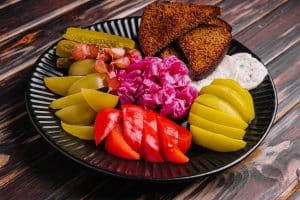
Murături: (Side dish) A general term referring to all pickled vegetables, preserved for winter. This can include cucumbers, tomatoes, cabbage, carrots, cauliflower, and watermelon. They are typically preserved in water with salt or vinegar, flavored with dill, garlic, horseradish, and mustard seeds. They are typically served as a side dish with rich meat dishes, like friptură or tonăciță.
Papanași: (Dessert) Dough made from cottage cheese, eggs, flour, and semolina, is shaped into a ball with a smaller ball on top. They are then fried or sometimes boiled, and topped with sour cream and fruit preserves (dulceață), especially blueberry, cherry, or strawberry. A beloved, popular, and very traditional Romanian dessert.
Pârjoale: (Main dish; appetizer) Minced pork, beef, or poultry is mixed with onions, garlic, milked-soaked bread, and herbs like parsley and dill, rolled into balls and usually flattened slightly, then fired or baked. They can be served alone, with bread, or as a side to mashed potatoes or buckwheat.
Pelmeni: (Main dish) Thin, round dough is filled with minced meat (pork, beef, or a mix), with salt, pepper, and sometimes herbs. Pelmeni are either boiled and served with sour cream or vinegar, or added to broth and served as a soup, also accompanied by sour cream. Originally of Russian origin.
Piftie: (Appetizer) Also known as ‘răcitură’, piftie is a savory meat jelly made by boiling pork parts rich in gelatin (like feet, ears, or hocks) with garlic, bay leaves, and peppercorns. It can also be done with rooster meat and feet. After 4-5 hours of boiling, the meat is arranged in deep plates, with the broth, often decorated with carrots slices and parsley, and left to sit in a cold place until the gelatin sets the broth.

Plăcinte: (Breads) One of Moldova’s emblematic dishes, plăcinte are stuffed flatbreads or pastries. Traditionally made with a thin dough that is either pan-fried or oven-baked, plăcinte come in both sweet and savory versions. Savory versions include cottage cheese plain or with dill and green onions, cabbage, potatoes, or pumpkin. Sweet fillings include apples, cherries, or sour cherries. They can be served hot or cold, at important events, or even as a street snack, and are found at any bakery.
Prune uscate cu nuci: (Dessert) A classic dessert in Moldova, consisting of dried plums stuffed with walnuts, sometimes soaked in syrup or covered in chocolate. They are served at festive occasions, but also available in supermarkets, especially the chocolate-covered versions produced by Moldova’s renowned Bucuria Chocolate Factory.
Sarmale (and ardei umpluți): (Main dish) Sarmale, or cabbage rolls, and ardei umpluți, or stuffed bell peppers, are dishes with Ottoman roots, and some of the most beloved dishes in Moldova. Sarmale are made from cabbage leaves or grape leaves filled with a mixture of rice, minced meat, onions, and herbs, then slow-cooked in tomato sauce. For a vegetarian or lent version, the minced meat is replaced by mushrooms. The same filling is used for stuffed bell peppers. Both are typically prepared together, and they are present on any holiday table.

Semințe de floarea soarelui: (Snack) Sunflower seeds, also called ‘răsărită’ is a popular street snack. They are usually roasted and salted, and eaten by cracking open the shells by hand or with your teeth.
Slănină: (Appetizer) Cured pork fat, salted and aged with garlic, paprika, and other spices. It can be smoked or left plain. It is served sliced thinly on bread with raw onions.
Smântână: (Dairy) Sour cream is a dairy product used extensively in Moldovan cuisine. It can be enjoyed on its own, or with traditional dishes like mămăligă, papanați, colțunași, sarmale and others. It is also used in cooking deserts, doughs, sauces and soups.
Telemea: (Dairy) A traditional brined white cheese from cow, sheep, or goat milk. Somewhat similar to feta, it can be creamier or firmer and saltier, depending on how long it has been aged. Telemea is eaten fresh with tomatoes and onions, crumbled in salads, or as a side with mămăligă. It can also be used in pastries like plăcinte as an alternative to cottage cheese.
Tocăniță: (Main dish) A versatile dish of stewed vegetables, legumes, mushrooms, and/or meat slow-cooked with onions, bell peppers, and tomatoes and flavored with garlic and sweet paprika. The most common versions are potato and meat-based (usually chicken, pork, or beef) versions. Served hot, garnished with parsley, and with mămăligă on the side. Versions that contain no meat are common, and are often served with grilled meats.
Țuică: (Spirit) A strong traditional spirit made by fermenting and distilling plums. It is usually homemade and consumed as a shot-sized amount. In some regions țuica is preferred to wine when making toasts.
Vărzări: (Bread) These small pies are made from yeasted dough, giving them a soft, bready texture. Commonly filled with cabbage, cheese, or cherries. Sour or bitter cherries are preferred, with the sourness offset by dusting the pie with sugar.

Vin: (Drink) Wine is the cornerstone of Moldovan cuisine. Moldova is known for both red and white wines, made from local grapes like Fetesca Neagră, Rară Neagră, Feteasca Regală, Feteasca Albă, Viorica, as well as other international varieties like Cabernet and Chardonnay. Among the most famous wine producers in Moldova are Chateau Purcaci, Cricova, Castel Mimi, Mileștii Mici, Asconi and others. While commercial wines are widely available, many prefer homemade wines, which is very common in Moldova.
Vișinată: (Spirit) A homemade cherry liqueur made by macerating sour cherries with sugar and alcohol. It is sweet and typically served in small glasses as a digestive or during gatherings.
Zeamă: (Soup) A beloved Moldovan sour chicken noodle soup, traditionally made with homemade noodles, chicken, carrots, onions, and flavored with borș or lemon juice. Fresh herbs like parsley or lovage are added at the end. It is served hot with sour cream and chili pepper (ardei iute) and bread.
Appendix of Gagauz Foods
One of the largest minority ethnic groups in Moldova is the Gagauz people, a Turkic Orthodox Christian nation. They are native to Southern Moldova, where they have their own autonomous region. Their cuisine blends Turkic, Balkan and local Moldovan influences. Gagauz restaurants can be found in Chișinău. Milk and meat-based dishes are the basis of their cuisine, accompanied by an array of breads and pastries. Many dishes are held in common with Moldovan cuisine. For instance, the Gagauz dish sarma is essentially the same as sarmale and thick cornmeal porridge, pickles, and wine are very common on Gagauz tables. A handful of other dishes are detailed below.
Shurpa: (Soup) Usually made with lamb or beef simmered with potatoes, carrots, onions, and peppers. It’s seasoned with black pepper, bay leaf, and fresh herbs, producing a rich hearty and aromatic broth.
Manja: (Main) Chicken is slow cooked in a spiced tomato sauce.

Kabakly: (Side; Main) A simple pumpkin-filled pastry associated with Lent.
Kaurma: (Main) Fried or stewed lamb or pork that can be served fresh or preserved in its own fat. Traditionally prepared in autumn for winter storage, kaurma is reheated or added to stews for flavor.
Kyvyrma: (Breads) This savory pastry is filled with salted cottage cheese, eggs, and sour cream. Often enjoyed with coffee or tea as a snack.
Gözlemya: (Breads) A thin, pan-fried flatbread stuffed with cheese, herbs, potatoes, and/or meat.
Gevraki: (Dessert) Small, crunchy, twisted pastries or cookies, often lightly sweetened or glazed. Eaten with tea or coffee, they’re similar to fried dough twists found throughout the Balkans.
You’ll Also Love
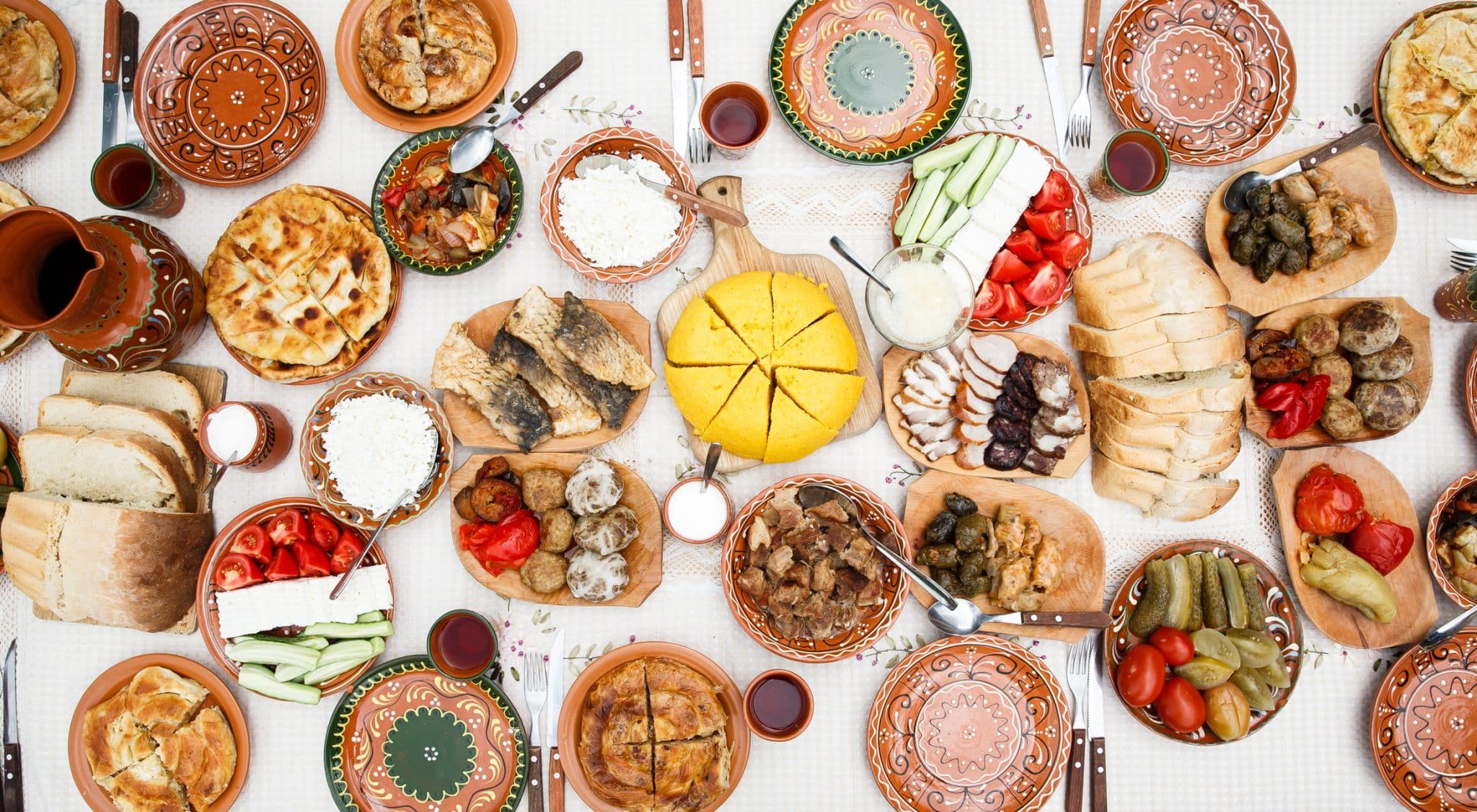
The Moldovan Food Dictionary
Moldovan cooking developed over centuries in the fertile lands between the Prut and Dniester rivers, where a temperate climate, rich soils, and rolling farmland supported abundant agriculture. Early inhabitants, including Thracians and Dacians, cultivated wheat, barley, and grapes, while herding sheep and cattle for dairy and meat. Roman rule expanded viticulture, but bread, dairy, and […]

The Talking Romanian (Moldovan) Phrasebook
The Talking Phrasebook Series presents useful phrases and words in side-by-side translation and with audio files specifically geared to help students work on listening skills and pronunciation. Below, you will find several useful phrases and words. To the left is the English and to the far right is the Romanian translation. In the center column […]




